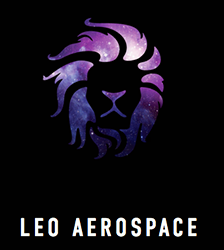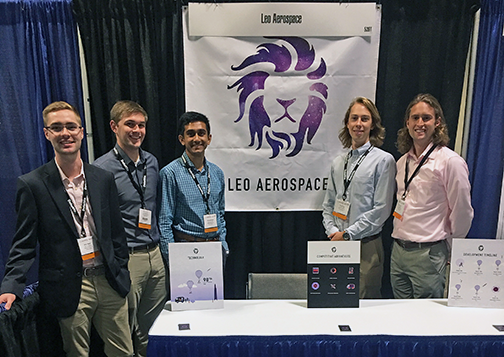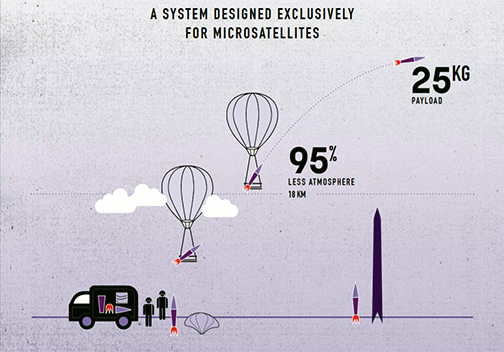
A Purdue University-affiliated startup is seeking to open up access to space for smallsat companies by modernizing a launch technique that was first used in the 1950s.
Leo Aerospace LLC plans to use "rockoons," or high-altitude balloons, that launch rockets into suborbital and orbital flights. Suborbital launches are frequently used by researchers who need access to zero gravity or vacuums for experiment, while orbital flights are used by satellites.

The founders are, from left, Mike Hepfer, head of product development; Drew Sherman, head of vehicle development; Abishek Murali, head of mission engineering; Dane Rudy; chief executive officer; and Bryce Prior, head of operations and strategy.
Officials of Leo Aerospace, which took its name from Low Earth Orbit, say the company will revolutionize the space industry by giving priority service to smallsat developers that now are secondary payloads for large rocket companies.
Currently, developers have to wait to see if there is room left on large rockets carrying government payloads and often have to wait six months or more to find space on a rocket, a delay that can be quite costly. Those smallsat developers also have limited options on which orbit their satellites are delivered to and when they are launched.
Leo Aerospace LLC was started by five then-Purdue University students as a club and then turned into a business. The founders are, from left, Mike Hepfer, head of product development; Drew Sherman, head of vehicle development; Abishek Murali, head of mission engineering; Dane Rudy; chief executive officer; and Bryce Prior, head of operations and strategy. (Image provided) Download image
The cost of sending a satellite into space can be up to $60,000 a kilogram. Leo Aerospace is confident it can lower that cost to launch microsatellites, which can weigh 1 to 50 kilograms. The rockoon, a hybrid of a rocket and high-altitude balloon, is less expensive to deploy than a traditional rocket since there is less drag because the rocket isn’t launched until the balloon is 11 miles above Earth, where there is 95 percent less atmosphere to cause drag.
“By doing that you can scale your rocket down much more efficiently,” said Sherman, who is pursuing a master’s degree at Purdue in engineering management with an emphasis on propulsion.

Leo Aerospace plans to use “rockoons” (high altitude balloons) that "launches" rockets about 11 miles (18 kilometers) above Earth, where there is 95 percent less atmosphere to cause drag. That makes the rockoon less expensive for smallsat owners to launch their spacecraft than a traditional rocket.
Leo Aerospace conducted a customer discovery and market validation study through the National Science Foundation I-Corps program and found a large demand to deploy smallsats.
The rockoon was first used by the U.S. Air Force in the 1950s. Leo Aerospace can precisely launch the rocket by controlling the pitch and angle using core integration technology, for which it has filed patents.
The company’s goal is to launch its first suborbital flight by 2020 and use these funds combined with a series B funding round, to launch its first satellite into orbit in 2022. Its long-term goal is to increase launch frequency as operations develop. The company has done some preliminary analysis work and some hardware testing.
Leo Aerospace plans to initially launch the rockoons from existing spaceports licensed by the Federal Aviation Administration. The spaceports stretch from the Kennedy Space Center in Florida to Kodiak Island in Alaska. The company plans to reuse the balloons for future launches, but the rockets will be used only once.
Leo Aerospace is now looking for funding to get off the ground. The company won $15,000 in March through the Burton D. Morgan Business Model Competition. Leo Aerospace already has raised more than $130,000 of its $250,000 goal through Netcapital, a private equity and venture capital firm. People interested in investing can get more information here. The company plans to seek Series A funding in the next two years.
Drew Sherman, Leo Aerospace’s head of vehicle development, said that the firm is targeting microsatellites by saying smallsat owners don’t have to ride-share with anyone and the firm will work with clients exclusively to get them into orbit. They wont' have to worry about other rideshare payloads or in getting "dropped off" in the incorrect spot.
Abishek Murali, head of mission engineering, said a selling point for Leo Aerospace will be the firm's flexibility and ability to meet customers’ needs. The company can tailor their launch vehicles and operational capabilities to the exact needs of its clients. He noted that the company's goal is to give people access to space. The only way to do that correctly currently is to help people get their satellite into orbit. That's where Leo Aerospace wishes to leave its mark.

